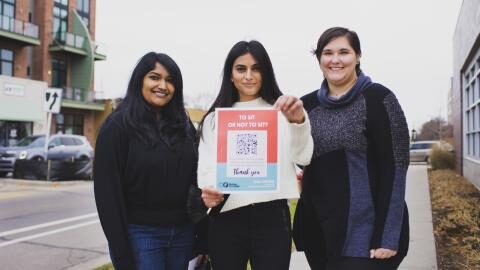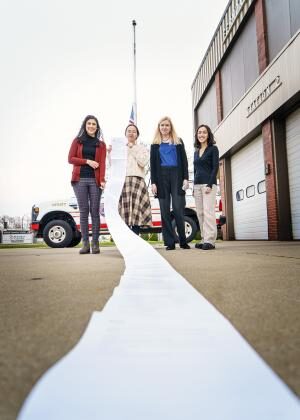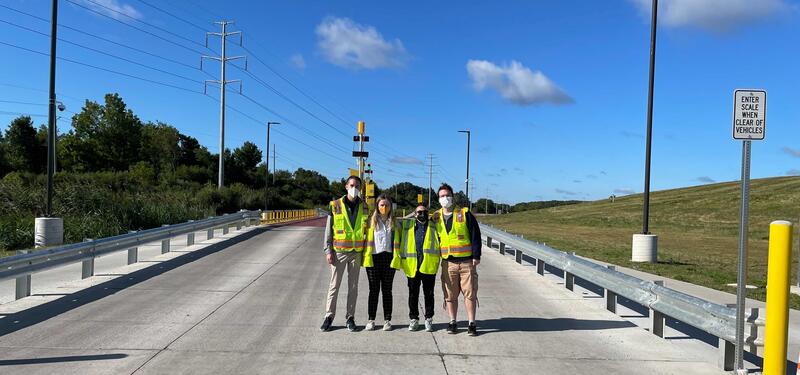What does the Ferndale Fire Department have in common with a compost facility in Ann Arbor?
When faced with disparate information challenges that hindered their goals, both received the accessibility and usability expertise they needed from students in the University of Michigan School of Information’s (UMSI) Citizen Interaction Design (CID) class.
SI 538: Citizen Interaction Design is a project-based, experiential learning course where students apply their skills to create information solutions in partnership with a Michigan community. Student teams work with their community partners to deliver tools and services that foster engagement with local residents.
Guided by UMSI civic engagement program manager and adjunct lecturer Scott TenBrink, fall 2021 CID students collaborated with seven public service departments within the cities of Ferndale and Ann Arbor to provide citizen-focused solutions for streamlining communications, facilitating interactions with technology, fighting misinformation and more.
“From my perspective, the Ferndale community has benefited greatly from the experience of working with Scott and his students,” says Greg Pawlica, the Ferndale city councilmember who helped establish the relationship between the community and UMSI six years ago. “I continue to be blown away by the creativity and ingenuity of the students.”

Applying user experience and accessibility expertise in Ferndale
Local businesses are legally required to report the hazardous chemicals they have onsite to the Ferndale Fire Department. However, the 18-page paper form given to business owners during yearly inspections was unwieldy and resulted in a low compliance rate. Ferndale’s fire department turned to Master of Science in Information (MSI) students Megan Chan, Alyssa Downs, Lizbeth Guerrero and Xinyi Wang for help redesigning their form and increasing submissions.
“We focused on the communication flow because we realized that without that proper flow the form just wouldn’t be filled out,” says Guerrero. “We created an informative flyer with a QR code that will link business owners to the hazardous chemical reporting form online.”
They wanted to make reporting hazardous chemicals as simple a process as possible for businesses, and digitizing the form was imperative to the success of their project. “Digitizing the form allowed us to provide an example form, a glossary, a how-to video and educational elements so business owners can learn more about the chemicals they have onsite,” says Chan. “Now because the form is really accessible and educational it’s more usable, meaning it’s better able to help firefighters keep the community safe, keep themselves safe and minimize damage when they know exactly what they need to know before they enter an emergency.”

Student teams also worked with the Ferndale Downtown Development Authority on a campaign to streamline communication with local businesses, and with the Ferndale Public Library to help educate patrons on local government.
MSI students Grace Song, Marivi Sifuentes, Shannon Kenny and Safa Viqar helped the Ferndale Community and Economic Development Department reimagine the website for the City of Ferndale to make it more navigable for users and create a clearer organizational hierarchy for anyone managing the site in the future.
“We received very positive feedback from a few people in the Ferndale community and from people in the City of Ferndale Communications Department,” says Kenny. “Because of our team’s evaluations of their site, communications staff feel like they have a better sense of the things that need to be improved, and they will likely use our designs to help inform future changes.”
Practicing the principles of human-computer interaction and fighting misinformation in Ann Arbor
“Frustration-free composting” was top of mind for Bachelor of Science in Information student Ashley Thompson and MSI teammates Reilly Potter, Joseph Miszcak and Dana Reik. They partnered with the City of Ann Arbor Public Works to create an approachable composting experience for local residents.
One of the greatest obstacles for local composters was the facility’s kiosk, which allows users to select the types of material they are picking up or dropping off. The kiosk is as integrated into users’ experience at the composting facility as an automated payment kiosk is at a parking garage, but it was congested with information and difficult for users to navigate. The team of UMSI students worked with the city staff to simplify the process and reduce the amount of confusing information users faced.

The prototyping process illuminated for the team how adding, removing or adjusting even a single element within an interface can affect a user’s whole experience. Ultimately, they found that kiosk use is one minute faster when using their final, pared-down prototype compared to its original interface.
MSI students Jason Fender, April Kim, Bahar Shahmammadova and Abdul Wasay helped the City of Ann Arbor’s IT Department empower Ann Arbor city maps users with the ability to track feedback submitted directly through the website. With the students’ proposed redesign, local residents tracking progress of public works projects via Ann Arbor city maps, for example, will be able to convey feedback through a broader range of options, and make sure someone hears them.
The students’ goal behind adding feedback tracking IDs to Ann Arbor city maps was to help users feel more involved in the technology. Often when people submit feedback, they don’t know where it goes or whether it’s considered. Tracking IDs let Ann Arbor city maps users know where their feedback stands and reach out to city staff, and IDs also allow city staff to contact users.
One project hits as close to home as your kitchen sink. MSI students Toby Yu, Einas Elamin, Kadence Tang and Sneha Hegde teamed with City of Ann Arbor Water Treatment Services to build trust in Ann Arbor water quality and fight misinformation about tap water.
“People research water quality online, but they find information from random sources that can be wrong or misguide,” says Yu. “The main goal of our project is to deliver trustworthy information about Ann Arbor’s water quality and avoid the spread of misinformation.”

The team set up a campaign to bring reliable, accessible information about Ann Arbor water directly to users. “Traditionally, users are required to look for the information themselves,” Yu says. “This creates a barrier: A website may be dense with information or difficult to use. Instead, we’re bringing vital information about water directly to contextual locations in users’ daily lives, for example, by posting information about water near campus water fountains.”
The team projects a reach of nearly 70,000 new U-M students, faculty and staff with their successful campaign. Their efforts were so effective that one member of their own team, a lifelong bottled water drinker, says they gained so much confidence in the treatment process they’re switching to tap from now on.
UMSI students helping communities
Greg Pawlica is looking forward to continuing to work with UMSI students who innovate and rejuvenate Ferndale’s public service departments. “Government moves slowly and has limited resources. The students bring additional resources, but most importantly they bring a completely different perspective. They have fresh ideas that are not bogged down by the limitations of history. They help us by redesigning the old processes that slow government down.”
Interested in leveraging the expertise of UMSI students? Learn more about client opportunities at UMSI.
Learn more about UMSI’s Master of Science in Information program and how to apply.
Contact: Martha Spall, UMSI writer


